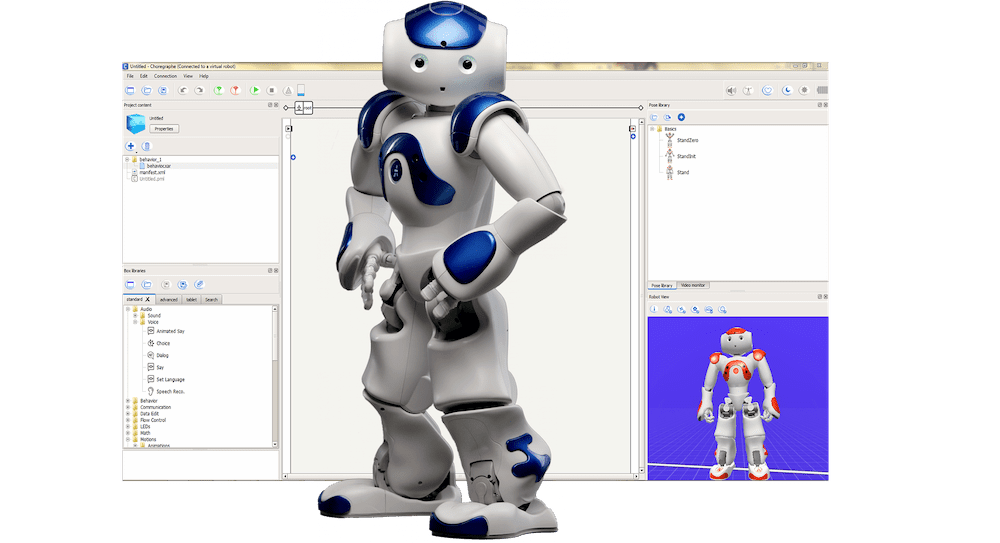Robots in Libraries: Technology Trends that Aren’t that Out-There Anymore!

Stephen Abram
I recently had the delight of chairing a panel at Internet Librarian where one of my panelists was Dewey—a physical robot developed by the Palo Alto City Library. Our panelists interacted with Dewey and other virtual robots like Alexa/Amazon Dot, Google Home, etc. As did the audience. We learned a lot. Most surprising was what we and the delegates learned they were already good at and where they failed (sometimes dangerously and sometimes humorously!).
Let’s look into where this heading. Robots can already write books and poetry. Robots can already read for comprehension (not just search keywords). Robots can already reply, ask for clarification and respond. This isn’t the realm of science-fiction any longer.
Coding with the Robot Workshop (Palo Alto City Library)
Make Dewey our humanoid NAO robot, move, talk and dance! Join our workshop designed for beginners to explore and learn coding with a robot.

Image courtesy of Palo Alto City Library
Robotics (and virtual robots)
ro•bot•ics
noun
the branch of technology that deals with the design, construction, operation, and application of robots
plural noun: robots
a machine capable of carrying out a complex series of actions automatically, especially one programmable by a computer.
synonyms:
automaton, android, golem;
• (especially in science fiction) a machine resembling a human being and able to replicate certain
human movements and functions automatically. –Oxford Dictionaries
“The field of robotics is often described as the subfield of AI that is concerned with perceptual and motor tasks. Robots are a mechanical device which performs automation tasks, either according to direct human supervision or a pre-defined program or a set of general guidelines, using artificial intelligence techniques.” –Shohana Nowrin
Robotics directly impacts libraries as well as the broader information (and social) environment in which libraries and librarians of all types work.
“It is true that computers can ‘read’ literature far faster and more comprehensively than any individual can. Nonetheless, it remains the case that a search is only as good as the search terms put in. A good librarian, through working with a user, can provide a much better tailored service, potentially using up time freed up by using AI.” –IFLA Library Policy and Advocacy Blog
Applications of Robotics in Library Activities
“Robot is “An automatically controlled, reprogrammable, multi-purpose manipulator programmable in three or more axes, which may be either fixed in place or mobile for use in automation applications.” The robots are scrambling, rolling, flying, and climbing. They are figuring out how to get here on their own. As libraries provide a growing array of digital library services and resources, they continue to acquire large quantities of printed materials. This combined pressure of providing electronic and print-based resources and services has led to severe space constraints for many libraries, especially academic research libraries. The goal of the Comprehensive Access to Printed Material (CAPM) is to build a robotic, on-demand and batch scanning system that will allow for real-time browsing of printed material through a web interface. The user will engage the CAPM system that, in turn, will initiate a robot that will retrieve the requested item. The robot will deliver this item to another robotic system that will open the item and turn the pages automatically. By using existing scanners, optical character recognition (OCR) software, & indexing software developed by the Digital Knowledge Centre, the CAPM system will not only allow for browsing of images of text, but also for searching and analyzing of full-text generated from the images. “–Researchgate; Dr. S. Mogali
It is interesting to note that, as the monkey selfie case has underlined, only human beings can claim copyright. Potentially, the programmer behind the AI could claim an interest, but with robots having the ability to write, create new works, etc., librarians will need to think about this.
Robots, visible like Robbie in Lost in Space, or a disembodied voice in the air or communications device, will once again change the way people look for information, at the expense of librarians—just as consumer search engines have already gone a long way to replicating the traditional role of libraries in helping find basic information. As robots become smarter, and emerge with more nuanced, smarter responses, we ignore them at our peril. Realistically, just as Google and their ilk have become our assistants, there is a wide range of opportunities for our field by exploiting technology interventions such as robots in libraries.
Robots in Libraries: Library-Shaped AI?
“…libraries are not powerless. Our community’s skills and values, as well as our institutions’ collections, have the potential to impact the development of AI. And by getting involved, we also have a chance to underline the importance of libraries to one of the most significant technological developments of today.” –IFLA
Further reading
- Bourg, Chris (2017), What happens to libraries and librarians when machines can read all the books, blog, 16 March 2017
- Coleman, Catherine Nicole (2017), Artificial intelligence and the library of the future, revisited, blog, 3 November 2017
- International Telecommunications Union, AI for Good
- Jacknis, Norman (2017), The AI-Enhanced Library, blog, 21 June 2017
- Johnson, Ben (2018), Libraries in the Age of Artificial Intelligence, InfoToday, January/February
- Mulgan, Geoff (2018), AI for Good: Is It for Real?, nesta blog, 23 July 2018
- Snow, Jackie (2017), Bias already exists in search engine results and it’s only going to get worse, MIT
- Technology Review, 26 February 2018
- Tay, Aaron (2017), How libraries might change when AI, machine learning, open data, block chain & other technologies are the norm, blog, 9 April 2017
- The Robots Are Coming? Libraries and Artificial Intelligence
– Stephen

Stephen Abram
Stephen Abram is a popular Lucidea Webinars presenter and consultant. He is the past president of SLA, and the Canadian and Ontario Library Associations. He is the CEO of Lighthouse Consulting and the executive director of the Federation of Ontario Public Libraries. He also blogs personally at Stephen’s Lighthouse. Check out his new book from Lucidea Press, Succeeding in the World of Special Librarianship! Read also Stephen’s other blog posts for Lucidea on how new technologies can be used in libraries and special libraries.
Similar Posts
Interview with Victor Baeza about ALA’s Library Instruction Round Table
Interview with Victor Baeza, President of LIRT, about how it benefits from and supports special librarians whose roles involve teaching or training.
Interview with Eugene Giudice, SLA Treasurer
Interview with SLA’s Treasurer about the future of the special library profession and how the Special Libraries Association can benefit librarians
Interview with Cara Marcus on Transportation Librarianship and SLA
Interview with Cara Marcus, the president of the Special Libraries Association (SLA) transportation community about transportation libraries and SLA
Interview with Christian Nappo on the National Librarians of Medicine
Interview with the author of a reference-ready book on the twenty-seven men and women who headed the National Library of Medicine.
Hosting service
Enjoy all of the benefits of your Lucidea solution with secure, reliable, stress free hosting
Programs & incentives
No matter your size or budget, we’ve got you covered, today and tomorrow





Leave a Comment
Comments are reviewed and must adhere to our comments policy.
0 Comments